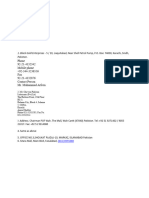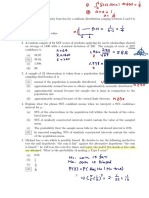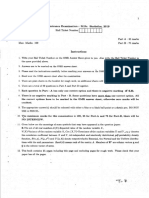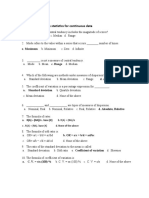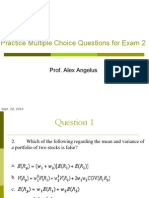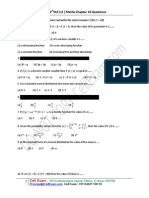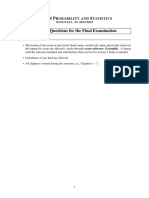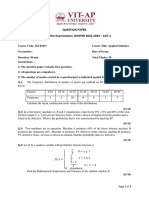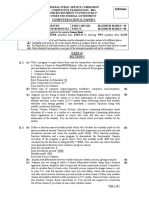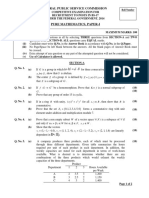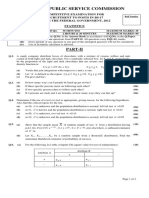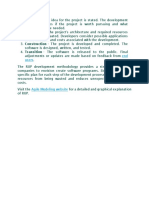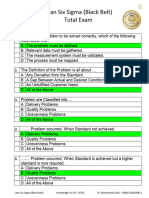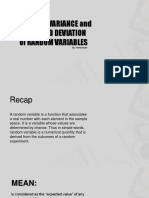FEDERAL PUBLIC SERVICE COMMISSION
COMPETITIVE EXAMINATION FOR Roll Number
RECRUITMENT TO POSTS IN BS-17
UNDER THE FEDERAL GOVERNMENT, 2013
STATISTICS
TIME ALLOWED: (PART-I MCQs) 30 MINUTES MAXIMUM MARKS: 20
THREE HOURS (PART-II) 2 HOURS & 30 MINUTES MAXIMUM MARKS: 80
NOTE: (i) First attempt PART-I (MCQs) on separate OMR Answer Sheet which shall be taken back
after 30 minutes.
(ii) Overwriting/cutting of the options/answers will not be given credit.
(iii) Use of Calculator is allowed.
PART-I ((MCQs) (COMPULSORY)
Q.1. (i) Select the best option/answer and fill in the appropriate Circle on the OMR Answer Sheet. (20x1=20)
(ii) Answers given anywhere, other than OMR Answer Sheet, shall not be considered.
1. Two mutually exclusive events are also:
(a) Dependent events (b) Independent events (c) Exhaustive events (d) None of these
2. In which definition of probability, the condition of mutually exclusive and equally likely events is
imposed?
(a) Subjective approach (b) Relative frequency (c) Classical definition (d) None of these
3. In Poisson distribution:
(a) Mean > Variance (b) Mean < Variance (c) Mean ≤ Variance (d) None of these
4. When sample size n becomes larger and larger and sample estimate tends to the respective population
parameter, this property of estimators is called:
(a) Unbiasedness (b) Consistency (c) Reliability (d) None of these
5. If the voting preference of 100,000 registered voters are to study, what kind of sampling should be
used?
(a) Simple Random Sampling (b) Quota Sampling (c) Stratified Random Sampling (d) None of these
6. If the sampling frame not available then which of the sampling technique could be adopted with ease:
(a) Simple Random Sampling (b) Stratified Random Sampling
(c) Cluster Random Sampling (d) None of these
7. The complete list of the sampling units is called:
(a) Sampling Frame (b) Unit List (c) Sample Space (d) None of these
8. A cricket captain wins the toss for three consecutive matches. What is the probability that he will call
correctly for the fourth match?
(a) 1/2 (b) 1/4 (c) 1/8 (d) None of these
9. If X has binomial distribution with parameter p and n then the variance of X is:
(a) n 2 pq (b) np (c) pq / n 2 (d) None of these
10. Suppose, we have a Poisson distribution with λ equals to 5 then the probability of having exactly 10
occurrences is:
5 −10 e −10 510 e −5 510 e −5
(a) (b) (c) (d) None of these
10! 5! 10!
11. Which of the following statement is true for Normal distribution?
(a) It is skewed to the right (b) It has always a mean of zero and a standard deviation of one
(c) Its mean, median and mode are equal (d) None of these
12. Which of the following statement is true?
(a) The slope coefficient in regression and the correlation coefficient always have the same sign
(b) A regression line always passes through origin (c) The correlation coefficient can exceed than 1
(d) None of these
13. Testing of hypotheses is a phase to check the validity of:
(a) Population parameter (b) Sample estimate (c) Population (d) None of these
14. Any set of outcomes of a random experiments is called:
(a) Event (b) Event space (c) Sample points (d) None of these
Page 1 of 3
�STATISTICS
15. When a difference between two groups is statistically significant this means that:
(a) The difference is statistically real but of little practical significance
(b) The difference is probably the result of sampling variation
(c) The difference is not likely to be due to chance variation (d) None of these
16. The degree of freedom for two independent samples will be based on:
(a) d.f = n1 + n2 − 2 (b) d.f = n − 1 (c) d.f = n1 + n2 + 2 (d) None of these
17. As the sample size increases:
(a) The standard deviation of the population decreases (b) The population means increases
(c) The standard error of the mean decreases (d) None of these
18. With a lower level of significance, the probability of rejecting a true null hypothesis:
(a) Remains same (b) Increases (c) Decrease (d) None of these
19. Which one is NOT the characteristic of a random experiment:
(a) It has at least two outcomes (b) The number of all possible outcomes are not known in advance
(c) It can be repeated any number of times under similar conditions (d) None of these
20. A 95% C.I for population mean is:
− −
(a) X ± 1.96σ 2 / n (b) µ ± 1.96σ / n (c) X ± 1.96σ / n (d) None of these
PART-II
NOTE: (i) Part-II is to be attempted on the separate Answer Book.
(ii) Candidate must write Q. No. in the Answer Book in accordance with Q. No. in the Q. Paper.
(iii) Attempt ONLY FIVE questions from PART-II. ALL questions carry EQUAL marks.
(iv) Extra attempt of any question or any part of the attempted question will not be considered.
(v) Use of Calculator is allowed.
Q.No.2. (a) Explain the classical definition of probability. (04)
(b) Three companies are bidding on a contract. The relative qualities of the companies are
such that Company A is twice as good as Company B, and Company B is three times
as good as Company C. what is the probability of each company winning the contract? (06)
(c) Given P(A)= 0.5 and P(A ∪ B) = 0.7:
(i) Find P(B) if A and B are independent.
(ii) Find P(B) if A and B are mutually exclusive.
(06)
(iii) Find P(B) if P(A B) = 0.5.
Q.No.3. (a) Two machines A and B produce 45% and 55%, respectively of the total number of
ball bearings produced by a certain factory. The percentages of defective output of
these machines are 3% and 6%, respectively. If a ball bearing is randomly selected,
find the probability that the item is defective. Find the probability that it was produced
by the machine A. (10)
(b) Suppose that the probability of success in an oral interview for civil services is 0.32. If
10 candidates are being interviewed,
(i) What is the probability that none of these will be succeeded?
(ii) What is the probability that at least half of the candidates will be succeeded? (06)
Q.No.4. (a) Assume that the weights (in pounds) of papers discarded each week by different
offices in a large secretariat, are normally distributed with mean 9.43 and standard
deviation 4.17 pounds. Find the probability that 5 randomly selected offices have
mean discarded papers between 10 and 15 pounds. If an office is selected at random,
what is the probability that it discarded less than 2 pounds paper during the last week? (08)
(b) The number of traffic accidents that occur on a particular stretch of road during a
month follows a Poisson distribution with a mean of 6. What is the probability that on
a randomly selected month, there are just 2 accidents on that road? Find the
probability that the next two months will both result in four accidents each occurring
on this stretch of road. (08)
Page 2 of 3
�STATISTICS
Q.No.5. (a) Differentiate between Type-I and Type-II errors. (04)
(b) A sociologist develops a test to measure attitudes about public transportation, and 27
randomly selected subjects are given the test, Their mean score is 76.2 and their
standard deviation is 21.4. Construct the 95% confidence interval for the mean score
of all such subjects. (06)
(c) A researcher claims that not more than 65% officers in the public offices come on time
in their offices. A random sample of 60 officers was taken on a random working day,
It was observed that 37 officers were in time. Test the claim of the researcher at 5%
level of significance. (06)
Q.No.6. (a) In an insurance study of worker’s deaths in a heavy mechanical complex of a country,
monthly fatalities are analysed for two different time periods. Sample data from the
both time periods are summarized by the following statistics:
n1 = 12 , x1 = 46.42 , s1 = 11.07 ; n2 = 15 , x2 = 51.06 , s2 = 10.39 ;
(06)
At 0.05 level of significance, test the claim that both time periods have the same mean.
(b) An exercise physiologist wants to decide whether a certain type of running program
will reduce heart rates. He measures the heart rates of 10 randomly selected people
who are then placed on the running program. One month later the exercise
physiologist again measures the heart rates of the 10 people. The heart rates, both
before and after the running program, are displayed as below:
Before Program: 68, 76, 74, 71, 71, 72, 75, 83, 75, 74;
After Program: 67, 77, 71, 70, 69, 70, 71, 77, 71, 74.
Do the data provide sufficient evidence to conclude that the running program will
(10)
reduce heart rates? (Use 5% level of significance.)
Q.No.7. (a) What is the difference between a correlation problem and a regression problem? Also
give the situation where we have to use partial correlation rather than simple
correlation. (06)
(b) The general manager of an engineering firm wants to know whether a draftsman’s
experience influences the quality of his work? He selects 10 draftsmen at random and
records their years of work experiences and their work quality rating (excellent = 5,
very good = 4, good = 3, average = 2 and poor =1).The data recorded are given as
follows:
Experience: 1 17 20 9 2 13 9 23 7 10
Rating: 1 4 4 5 2 4 3 5 2 5
Find correlation coefficient between experience and rating. Also interpret the result. (10)
Q.No.8. (a) What are the advantages of sampling? Differentiate between random and non-random
sampling. (06)
(b) What do you understand by sampling distribution? For a population of with elements
2, 4, 6, 8, 10, draw all possible random sample of size 2 without replacement and
compute sample means. (10)
Q.No.9. Write note on any FOUR of the following: (04 each) (16)
(a) Mathematical expectation of a random variable
(b) Applications of the Chi-square distribution
(c) Analysis of variance (ANOVA)
(d) Stratified random sampling
(e) Applications of Statistics in the public health issues
(f) Applications of Statistics in economic development
*************
Page 3 of 3





